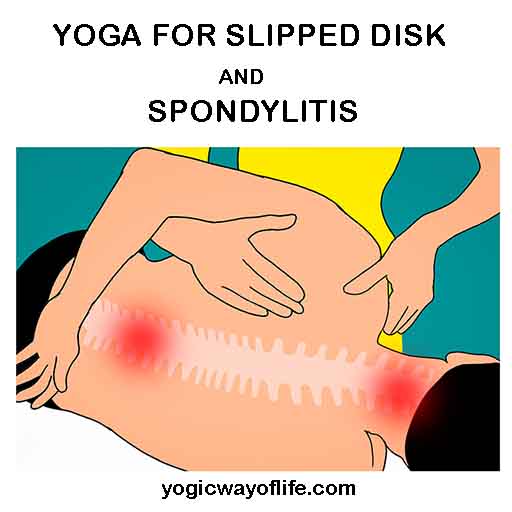Yoga for Slipped Disk and Spondylitis is based on backward bending asanas, pranayama and yogic relaxation poses. Slipped disk and spondylitis are mostly related to lifestyle and posture defects. The human body has 33 vertebrae, including the 5 that are fused to form the sacrum and 4 that form the tailbone. Disks are the fibrous padding material between 2 vertebrae. It consists of a tough outer layer and a jelly like soft inner layer. The disks act as shock absorbers, when we walk and engage in other movements.
What Causes Slipped Disk?
Slipped disk is a condition in which a disk in the spinal column becomes displaced from its normal position and presses on the spinal nerves, causing pain. Slipped disk usually develops over a period of time. Sometimes it can be caused by sudden jerky movements and weak spinal muscles. It can also be caused by rupture of the outer tough layer of the disk.
Some slipped disk conditions can be cured by proper rest and exercise. Severe conditions may require medical attention and surgery.

Yoga Management of Slipped Disk
Yogic management of slipped disk is based on using certain postures which strengthens the spinal muscles and ligaments that hold the spine together. They are practiced along with other asanas that give rest to the spine. Constant practice of these yogic postures will slowly reverse the bulge in the spine; thereby relieving the pain caused by the disc pinching the spinal nerves.
In most cases, these conditions occur due to wrong posture or bad work habits, over a period of time. When we perform Yoga asanas with awareness, we develop an understanding of our own body. This helps us to figure out ways to avoid those bad postures and work habits which lead to unnecessary stress and strain on the spine. We can re-train our mind to sit and move with a good posture.
The most common Asana used for Slipped disk management is Makarasana or the crocodile pose. Advasana, Shavasana and Jyestikasana are also used as resting poses. After practicing these for some time, the muscles and ligaments will become stronger. Then the other backward bending asanas can be taken up. Forward bending asanas should be avoided for back problems, as it may aggravate the condition. Consult an expert yoga teacher, before you take up these postures. Always start with the asanas which may be easier to perform. Never strain your back while performing these asanas. Marjariasana can be done to strengthen the back and shoulders and to bring flexibility to the spine.
You can start with stage 1 and go up to stage 3. Move on from one stage to another only if you are comfortable. Each stage requires a higher strength of the back and neck muscles than the previous ones.
The postures that can be performed during each stage are as follows:
Stage 1:
- Makarasana (The crocodile pose)
- Jyestikasana (The superior Pose)
- Advasana (Reversed Corpse Pose) & Shavasana (Corpse pose) as resting pose
Stage 2:
- Bhujangasana (cobra pose)
- Ardha Shalabhasana (half Locust pose)
- Ardha Chakrasana (half-moon pose)
- Marjariasana (The Cat pose).
Stage 3:
- Shalabhasana (The full Locust Pose)
- Dhanurasana (The Bow Pose)
- Ushtrasana (The Camel Pose)
In all the stages, Advasana, Shavasana, Jyestikasana and Makarasana can be used as resting poses.
Apart from asanas, one can take up practices to improve the flow of prana in the body. Pawanmuktasana is especially helpful in this as it removes many pranic blocks in the joints and is good for arthritis and stiff joints. Practice of pranayama can be taken up to increase the pranic level and bring flexibility in the whole body. Proper flow of prana in the body itself relieves much of the pain and stiffness.
You may try this simple exercise. Sit in a chair with spine straight and palms resting on the thighs. Relax the shoulders and neck muscles and look straight. Now breathe in a slow, deep and rhythmic manner. Let your awareness be on the natural breathing process. Make sure you are breathing from the abdomen. Observe your abdomen expanding and contracting. Do this for 5 minutes. You will notice a difference in your energy level and and a sense of well being.
Thus we see that slipped disk can be managed with a combination of postures, breathing exercises and relaxation.
